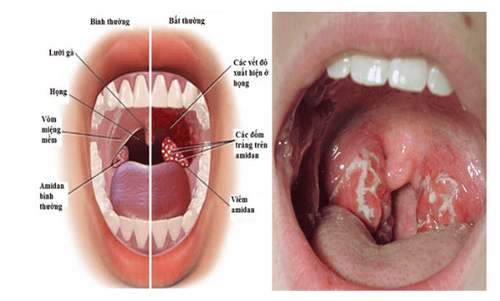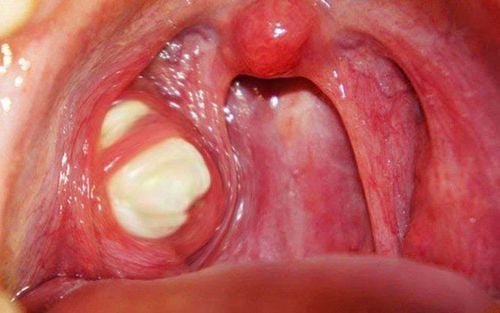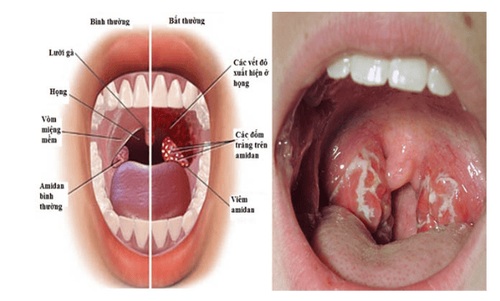This is an automatically translated article.
The article was professionally consulted by Specialist Doctor II Le Thanh Cam - Department of Pediatrics - Neonatology - Vinmec Danang International General Hospital.Bleeding after tonsillectomy is not uncommon and it can be long-lasting. Most of the time it's just a very small amount of bleeding and even you can only detect this when you see a little bit of blood on the tongue. However, if you are bleeding profusely or have spitting up, coughing and vomiting blood, or bleeding that doesn't stop, see your doctor right away.
1. When should tonsils be removed?
The tonsils are the immune barrier in the oropharynx. When the tonsils resist the invasion of pathogens into the nasopharynx in excess, tonsillitis will occur with symptoms of swelling and redness. The results of the destruction of bacteria in the tonsils often leave bacterial corpses, necrotic tissue into lumps of pus. When the tonsils are inflamed many times, the ability to fight bacteria is weakened, from the inflammatory foci located in the tonsils, it is the starting place for inflammation in the throat area.
The cause of tonsillitis may be due to upper respiratory tract infection, viral infection, flu ... Patients with tonsillitis have symptoms such as:
High fever over 39-400C tonsils are red and swollen and may have false symptoms. White mucous membrane clings Dry neck, neck pain, difficulty swallowing and headaches on both temples Nasal congestion, nasal discharge, mucus, clear, then thicker, white or yellow...

Repeated tonsillitis, if not treated promptly, can leave complications such as: scarlet fever, abscess around tonsils, acute arthritis, glomerulonephritis... However, not every Tonsillitis is to cut, cut tonsils only in the following cases:
Frequent inflammation, many recurrences, 5-6 times in a year Abscesses and causes complications such as otitis media, sinusitis or other complications Severe symptoms such as rheumatic heart disease, arthritis, glomerulonephritis The tonsils are too large, obstructing the airway, snoring, sleep apnea or repeated infections affect the patient's life... Tonsillectomy when there are many nooks and crannies containing many secretions causing bad breath, swallowing problems or suspicion of malignancy...
2. Causes of bleeding after tonsillectomy
Video
Due to a mistake in indications:
The cause of bleeding after tonsillectomy may be due to the ongoing pharyngitis. The patient has blood disease or is menstruating. Due to technical errors:
Residual tonsillectomy The process of cutting the posterior and anterior pillars (the pharyngeal muscles), when the muscle is broken without sutures, there is usually persistent bleeding but not strong bleeding. The lateral wall of the pharynx includes the fascia and pharyngeal muscle, leading to damage to the arteries inside the pharynx wall, causing bleeding after tonsillectomy. Tonsillectomy with forceps, this technique does not enter the specified dissection cavity, usually goes beyond the lateral wall of the pharynx, into the dangerous point behind the tonsils is the internal carotid artery Injury to the ascending palatal arteries and arteries The tonsil vessels in the base of the pedicle will cause bleeding after tonsillectomy, sometimes requiring ligation of the external carotid artery. During the separation of the anterior pillar, if too many abutments are torn close to the median line, it may cause damage to the palatal artery. downward
3. Management and monitoring of bleeding after tonsillectomy

3.1.Follow-up after tonsillectomy Must monitor bleeding early in 24 hours after tonsillectomy After tonsillectomy, the patient should not exercise vigorously and need to lie on one side without a pillow to avoid injuring the cut leading to bleeding In the first 2 days, the patient drinks milk, the next 3 days eat thin porridge, from the 7th day onwards can eat sticky rice, after the 10th day can eat normally. Avoid acidic, spicy, salty, hot and hard foods and drinks Usually, bleeding after tonsillectomy 7 days or earlier, later, at this time it is necessary to quickly check and intervene promptly. 3.2 Management of bleeding after tonsillectomy Local management:
When bleeding after tonsillectomy, the patient should suck on small ice cubes, swallow or spit, can put ice cubes in a plastic bag to apply next to neck Use a cotton ball impregnated with a hemostatic solution such as hydrogen peroxide and then press firmly on the tonsil pit at the right point of bleeding for about 10 minutes. Inject 1 ml of novocaine 1% mixed with adrenaline at the exact bleeding site to compress the capillaries to stop the bleeding. Use a 17cm-long Kocher tongs to clamp on the bleeding site for one hour. After removal if bleeding persists, sutures must be sutures Vascular sutures are applied specifically to arterial or venous bleeding, upper extremity or tonsil peduncle, intraoperative or postoperative bleeding. After 7 days termites will fall off on their own. Place Boisviel compression forceps for bleeding in the tonsil stalk and deep lingual fissure.

Coagulation by using Kocher forceps to clamp the bleeding site. Place the inactivated electrode on one side of the patient's arm and then move the active electrode of the coagulation machine into the Kocher clamp, then the organization at the tip of the clamp will be burnt to dark gray and the blood vessels will be coagulated. Sew the two pillars together according to Tarnaud's method, sew 2 or 3 stitches (cagut or white thread) through the back post to the front post, then tie the two posts together, insert a piece of wick between the two posts. The sutures are about 5 mm from the free edge of the abutment. If a normal wick is placed and sutured with normal sutures, remove the wick 24 hours after and 3 days after the suture is removed. External carotid ligation or embolization should only be used when all of the above methods of hemostasis have failed. Systemic treatment:
Inject drugs to enhance blood clotting for the whole body Inject heart drugs Infuse salt and sweet fluids Transfuse fresh blood if necessary Vinmec International General Hospital examines and treats ear and nose diseases common throat, head and neck tumors, congenital malformations in the ENT region by the most optimal internal-surgical methods for patients, both children and adults. Coming to Vinmec International General Hospital, patients will receive a direct, dedicated and professional examination from a team of qualified and experienced medical staff.
Please dial HOTLINE for more information or register for an appointment HERE. Download MyVinmec app to make appointments faster and to manage your bookings easily.














